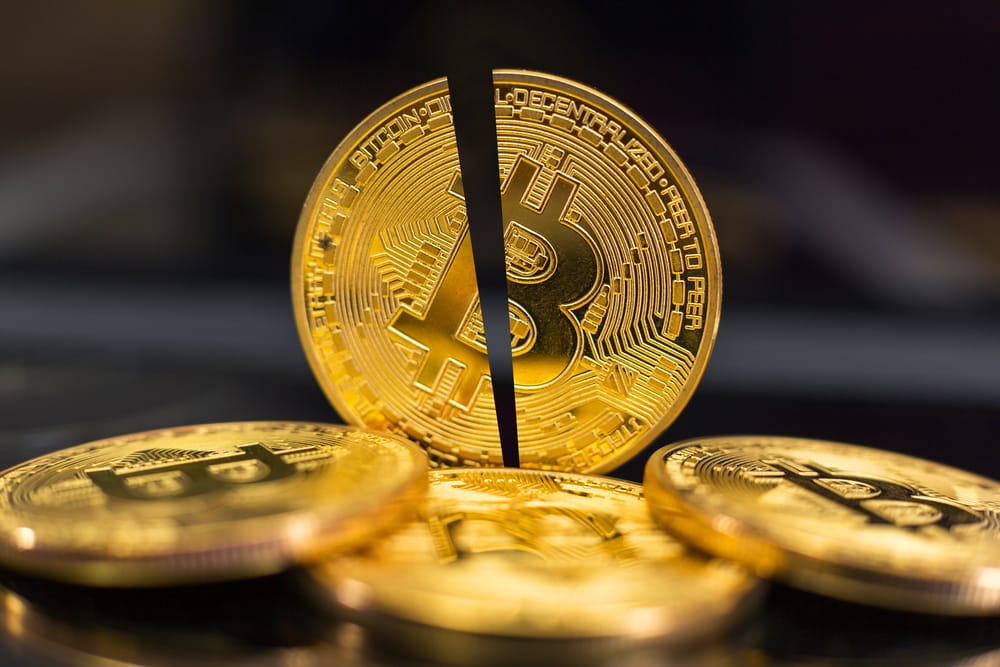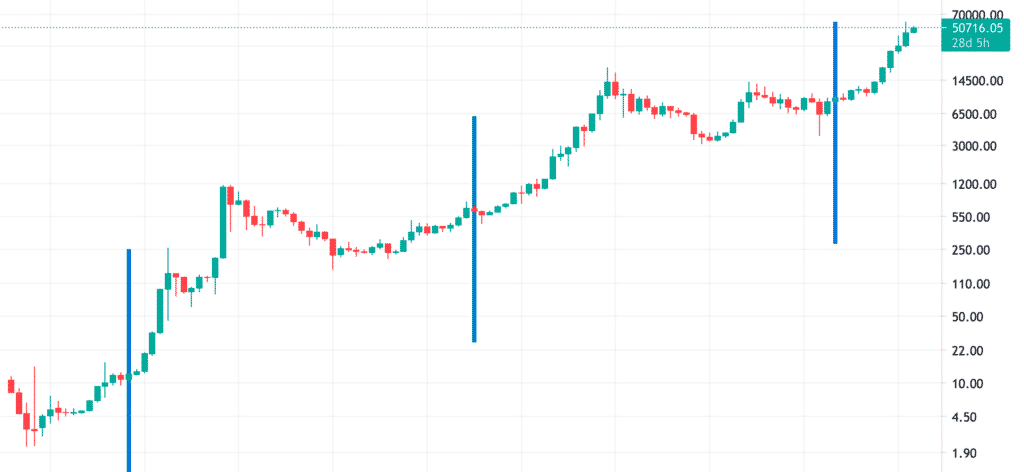
2021 has arguably been the most volatile year in Bitcoin’s history. This leading cryptocurrency in market capitalization hit an ATH of a little North of $64,000 in April. Since then, it went on to lose nearly half of its market value after China’s ban on cryptocurrencies and mining activities. In addition, tech billionaire and Tesla CEO Elon Musk went back on his decision to accept BTC as payment for Tesla.
Despite that, the adoption rate of this crypto coin went up in 2021. Several institutions, among them Paypal, JPMorgan, Visa, and Apple, recently adopted Bitcoin. Further, some countries such as El Salvador have accepted Bitcoin as legal tender. In October, Bitcoin ETFs were introduced to the New York Stock Exchange, which further drove the coin’s price up, smashing past previous all-time highs. On 20th October 2021, Bitcoin met a new ATH of $66,974.
What is halving?
New Bitcoins are obtained through mining. This mining involves several CPU-enhanced computers trying to guess a 64-character solution to a computational problem on Bitcoin’s network. This solution is called a hash. Every 10 minutes or so, a successful miner gets the hash and is tasked with verifying a block of transactions on the network. Once they do this, they lock the block so it cannot be changed.
In return, this successful miner gets rewarded with a number of BTC. When Bitcoin was introduced in 2009, the reward for successfully overseeing a block of transactions on the BTC blockchain was 50 BTC. This was meant to incentivize more miners to contribute to the network, even before the record-breaking success of the BTC coin was known for sure.
The total supply of Bitcoin in existence is 21 million units. Each time 210,000 blocks are mined, the reward given to successful miners is reduced by half. This is called bitcoin halving or halvening. The first 210,000 blocks were mined in 2012. Immediately, the reward went from 50 BTC to 25 BTC. Since then, this halvening has been happening every four years. Currently, the reward for mining a successful block on the blockchain is 6.25 BTC.
What’s the essence of halving?
At face value, halving seems counter-intuitive because the lessening rewards for mining Bitcoin may discourage miners. Especially considering the high costs of electricity and hardware requirements needed to mine, reducing miner rewards seems like a really terrible idea.
However, mining contributes to the deflationary nature of Bitcoin. Fiat currency, in comparison, can be printed at will. This phenomenon became evident during the COVID-19 pandemic when most governments were introducing quantitative easing programs. Basically, they were injecting money into the economy with no corresponding economic growth. If such an economy fails to grow to catch up with the money supply, it leads to inflation, which is the reduction of a currency’s purchasing power.
Bitcoin, however, has a known and steady supply. Halving reduces the supply of Bitcoin with no commensurate change in demand. This tends to drive the coin’s prices up, hence increasing its purchasing power.
Effects of halving
To date, there have been three Bitcoin halvings in history. The first halving was in November of 2012. At the time, BTC was trading at $12. A year or so later, the coin’s price had rallied to nearly $1,000. The second halving event happened in July of 2016. By then, it was trading at $670. By the same time in 2017, it was trading at $2,550. At the end of that year, it had hit its ATH of the time, trading around $19,700.
The last halving happened in May of 2020 amidst the Covid-19 pandemic. Even as major currencies of the world struggled, Bitcoin experienced growth in value, blowing past previous ATHs by the end of the year.

In the figure above, the blue lines show the three Bitcoin halving events. Looking at the BTC price chart, we can see that each halving preceded a bull run for the coin, even though it was not instantaneous.
In addition, each halving effectively serves to reduce BTC’s inflation. Before the 2012 halving, Bitcoin’s inflation rate was at 50%. After the halving, it fell to 12%. After 2016’s halving, it fell to around 5%. Currently, the inflation rate is at 1.77% per annum.
2024 halving in focus
The next BTC halving is expected to fall sometime in the Spring of 2024. Historically, all halvings have been followed by a bull run for the coin, and 2024 should be no different. This is because the supply of BTC will be even scarcer, which is likely to drive the prices up. Further, the inflation rate of BTC will fall further, as it has every time it’s been halved.
In the short term, however, miners will need to improve the efficiency of their mining rigs. This is because the cost of electricity and hardware required to successfully mine a block may not be offset by the mining reward. Therefore, they will need to invest in hardware that delivers faster hash rates while consuming less energy. This way, they can reduce their overhead costs to stay in profit.
Alternatively, we may see a number of miners moving to other assets that are easier to mine, such as bitcoin cash or other coins on the Ethereum blockchain.
Conclusion
Bitcoin halvening refers to the reduction of miner rewards by half every time 210,000 blocks are mined on the blockchain. This phenomenon helps to keep the cryptocurrency’s supply in check amid its growing demand. Since its inception in 2009, BTC has seen three halving events in 2012, 2016, and the most recent being in 2020. Each halvening has been a catalyst for a bull run for the coin, and the incoming halving of 2024 will likely have the same effect. Additionally, halving serves to reduce BTC’s inflation rate. We expect to see its inflation rate fall further after 2024.







